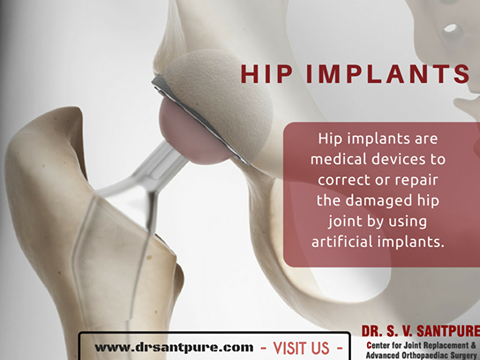What is Hip Implants Surgery?
Hip implants are medical devices to correct or repair the damaged hip joint by using artificial implants. The hip implants differ in size, material and dimension. The same implant may have different effects for different people. Hip implants are not forever, they tend to wear out. The average shelf life is 10-13 years. Various factors contribute to its longevity such as the age, body weight, sex, activity level, surgery conditions and type of implant.
Procedure: The surgery involves making an incision depending on the approach and removing the old joints. A new implant will be placed in its place to support the bones. There are three hip replacement procedures-total hip replacement, partial hip replacement and hip resurfacing.
- Total Hip Replacement: an artificial joint is used to replace the entire hip joint. A stem is inserted for stability and a ball on its top. An artificial cup replaces the socket. Cement is used to secure the implant in place. Some surgeons also make use of cement-less methods.
- Partial Hip Replacement: when only one section of the hip requires repair, partial hip replacement is done. Usually, a partial hip replacement is done in case of fracture.
- Hip Resurfacing: hip resurfacing is done to avoid bone loss at the surface. An artificial cup is placed in place of the socket. The top is covered with cement. Arthritis patients undergo hip resurfacing.

Types of Implants:
- Metal on Polyethylene
- Ceramic on Polyethylene
- Metal on Metal
- Ceramic on Ceramic
- Ceramic on Metal
Complications: Every surgery has its benefits and risks. Some conditions are detected at an early stage while some after years of surgery. Some of the complications in hip replacement surgery are as follows:
- Infections are a major drawback of the surgery. Bacteria tends to grow on the implants, leading to serious infections.
- Dislocation may occur with general wear and tear of the joints and cause instability.
- Blood clots occur in the muscles and tissues nearby and are passed directly to the lungs.
- Fractures may occur during the surgery. Some are minor and heal on their own. Larger fractures may require surgery.
- Inequality of legs may seem to happen. Legs may seem lengthened or shortened. Both can be rectified.
- Metal toxicity may occur as the implants made of metal leave their ions. Usually the body eliminates it, but for some it may accumulate and enter the blood stream causing metal toxicity.









